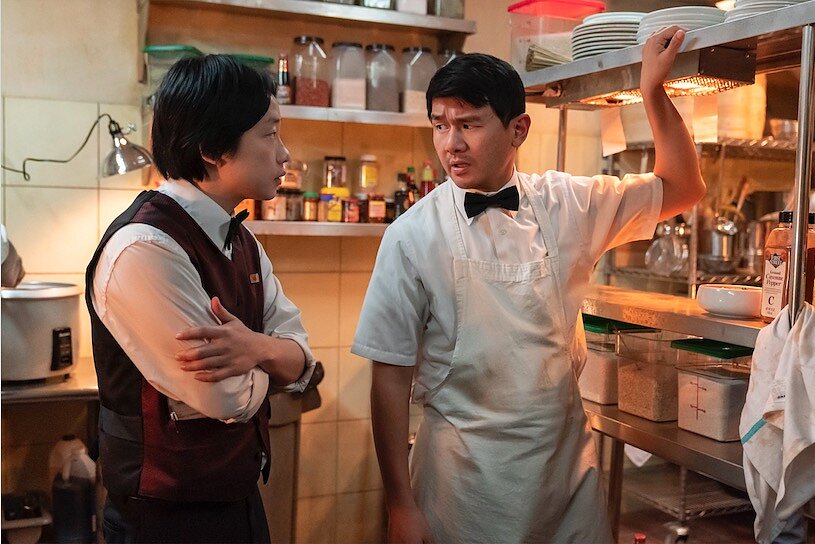Charles Yu’s Mind-Bending “Interior Chinatown”
The idea for author Charles Yu’s fourth novel, Interior Chinatown, was first sparked when Yu spied an anonymous Asian performer in the background of a Chinatown-themed episode of Law & Order. He wondered what that world looked like through the eyes of this backgrounder, watching the action and the stars from the margins. With its prose stylized like a screenplay, in Interior Chinatown, various Asian background and supporting actors assume various stereotypical roles in order to assimilate into film productions and get paid. The novel’s protagonist, Willis Wu, aspires to be cast as “Kung Fu Guy” but his film universe subjects him to lesser roles like “Delivery Guy” or “Disgraced Son.”
Yu is also at the helm of Hulu’s on screen adaptation of Interior Chinatown. Hong Kong-American actor/comedian Jimmy O. Yang embodies the role of Willis, who we first see as a Chinatown waiter. He is not conscious that he exists in a metafictional television show with surreal rules he doesn’t understand. In one of the show’s first gags, Willis can’t open the restaurant’s exit door because a literal invisible force forbids him from entering new spaces.
Willis senses his world is about to change when police detectives Miles Turner (Sullivan Jones) and Sarah Green (Lisa Gilroy) conduct a gang war investigation in Chinatown (a scenario that spoofs Law & Order Chinatown-set episodes down to the canonical dun-dun sound effect). Underlying all of this is the mystery of Willis’s missing older brother, credited as “Older Brother,” played by Chris Pang, whom Willis idolized as his ideal “Kung Fu Guy.” To find his brother, Willis secretly partners with Detective Lana Lee (Chloe Bennet), the newest officer of the investigative force who happens to be acquainted with Willis’s brother. For mysterious reasons, the other detectives treat Willis as an invisible background character while Lana is able to see and interact with Willis. Like Willis, these detectives seem equally unaware that they are in a television show.
Willis’s odd reality illuminates the show’s social commentary on feeling pigeonholed as an Asian stereotype in American media and yearning to be worth a versatile role. Ahead of the show’s recent premiere on Hulu, Yu spoke to Caroline Cao to discuss the mind-bending metatextual worldbuilding of Interior Chinatown and how Willis’s and Lana’s contrasting Asian identities inform their relationship with Chinatown, Asian invisibility, and marginalization in the film industry.
Minor spoilers for “Interior Chinatown” follow.
CY: It feels scary. It feels inspiring. I learned a lot from it. They’re all directors, so they think visually. They’re also storytellers as well. I sometimes would come into a meeting with one of those directors and ask, “How are we going to do this?” And they already have several ideas. I learned so much about thinking in pictures instead of thinking in words.
You mentioned four amazing directors. They’ve all got different styles. Taika directed our pilot, so he helped set the look for the whole show. But John Lee, our producing director, was really instrumental in shaping the show and helping me understand what a viewer is thinking or not thinking: “We have a gap here. You need more information in this part. This is why this cut isn’t working because it’s confusing. You need this shot, or we need this little interstitial scene.” Ben Sinclair created his own TV show, High Maintenance. He brings his own flavor, heart, and humor. It’s incredible to work with those directors and more. Alice Wu, an amazing feature director, is also on the show.
CY: I think you already articulated it better than I’m going to: ambivalence over being pigeonholed. It could be easy for one version of the conversation to say, “Well, there is Asian representation now, so what’s the problem?” I think it’s more like, “What kinds of things could be relevant in a world where we have Everything Everywhere All At Once?”
We do have representation, but there’s still many more stories to be told, including ones about representation, about being pigeonholed, or being reduced, not just on screen but in our lives. Whether you’re Asian American or not, I hope people can take away that there’s more under the surface. Interior Chinatown is about getting under the surface.
CY: The big one for me was *Sixteen Candles *and Long Duk Dong. I feel like it was junior high when I saw that movie. It definitely stuck with me because it was a pretty big role in a very big movie that I otherwise loved. It’s uncomfortable to watch this thing about these wonderful people in this love story, and then you’ve got a character [an Asian stereotype] like that in the middle of it.
Early on, you understand you don’t have any kind of reference to Asia or Asian Americans. It’s all sorts of the Asian Other [on television and film]… It’s hard, growing up and sort of never seeing that on TV. That really shapes your perception as not being and not mattering. I think that’s how you end up being in your 40s and wanting to write a book about an invisible background actor.



